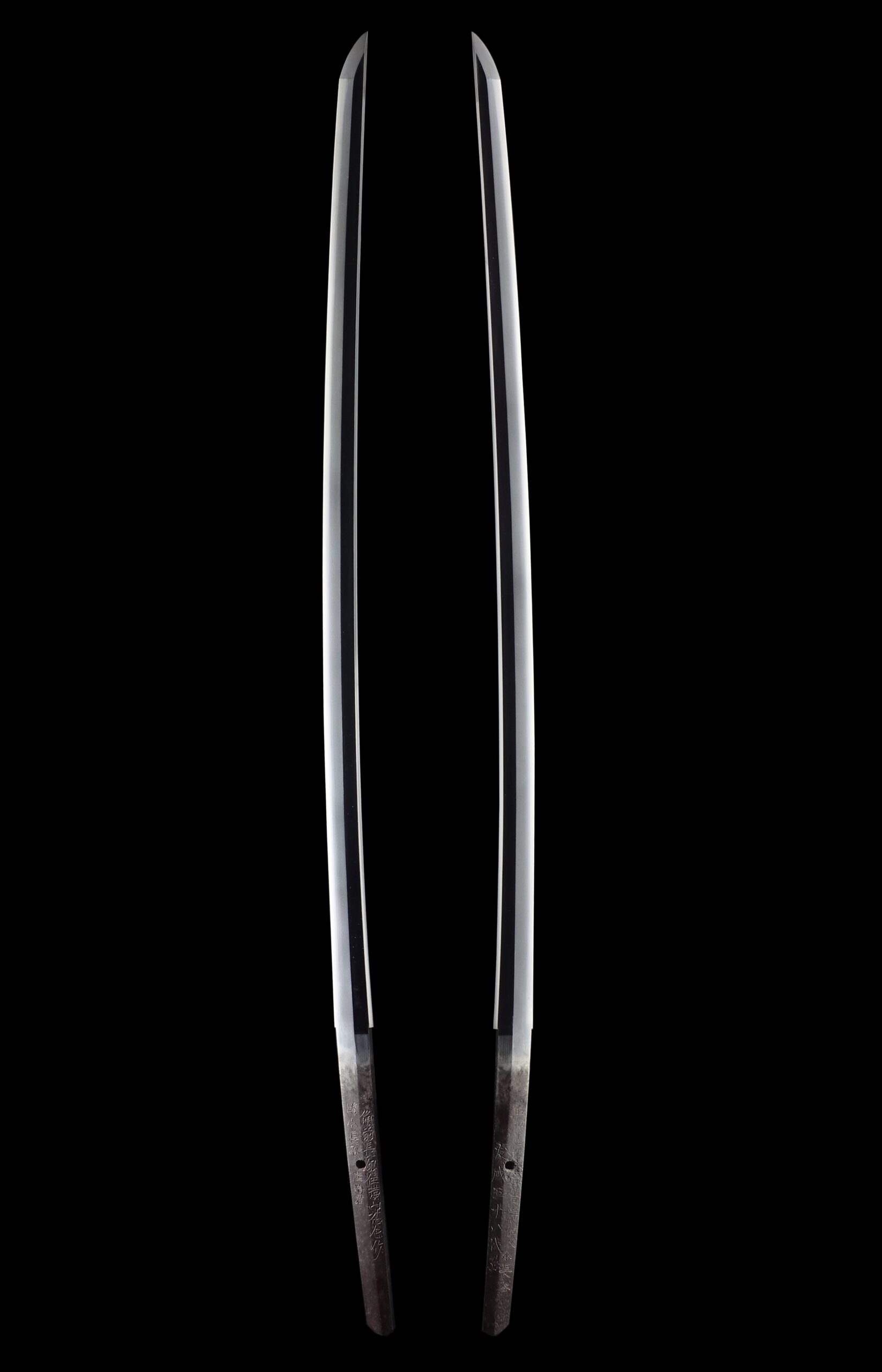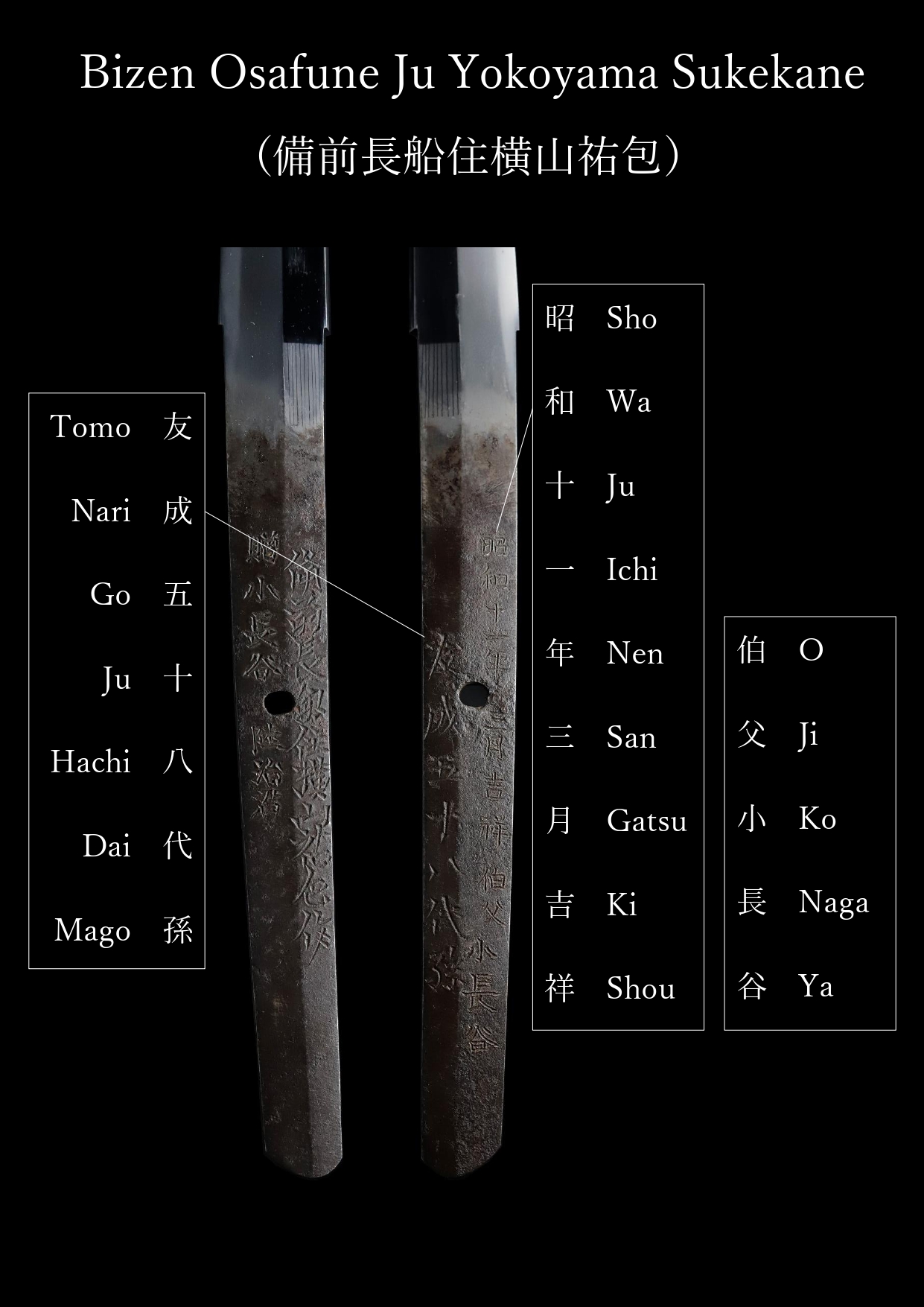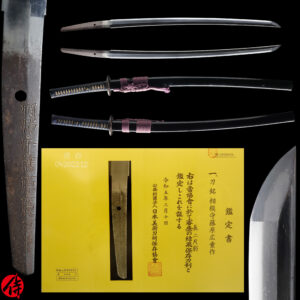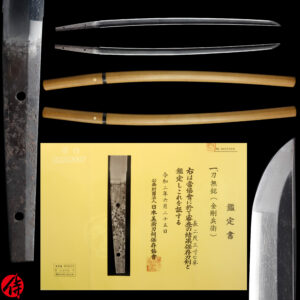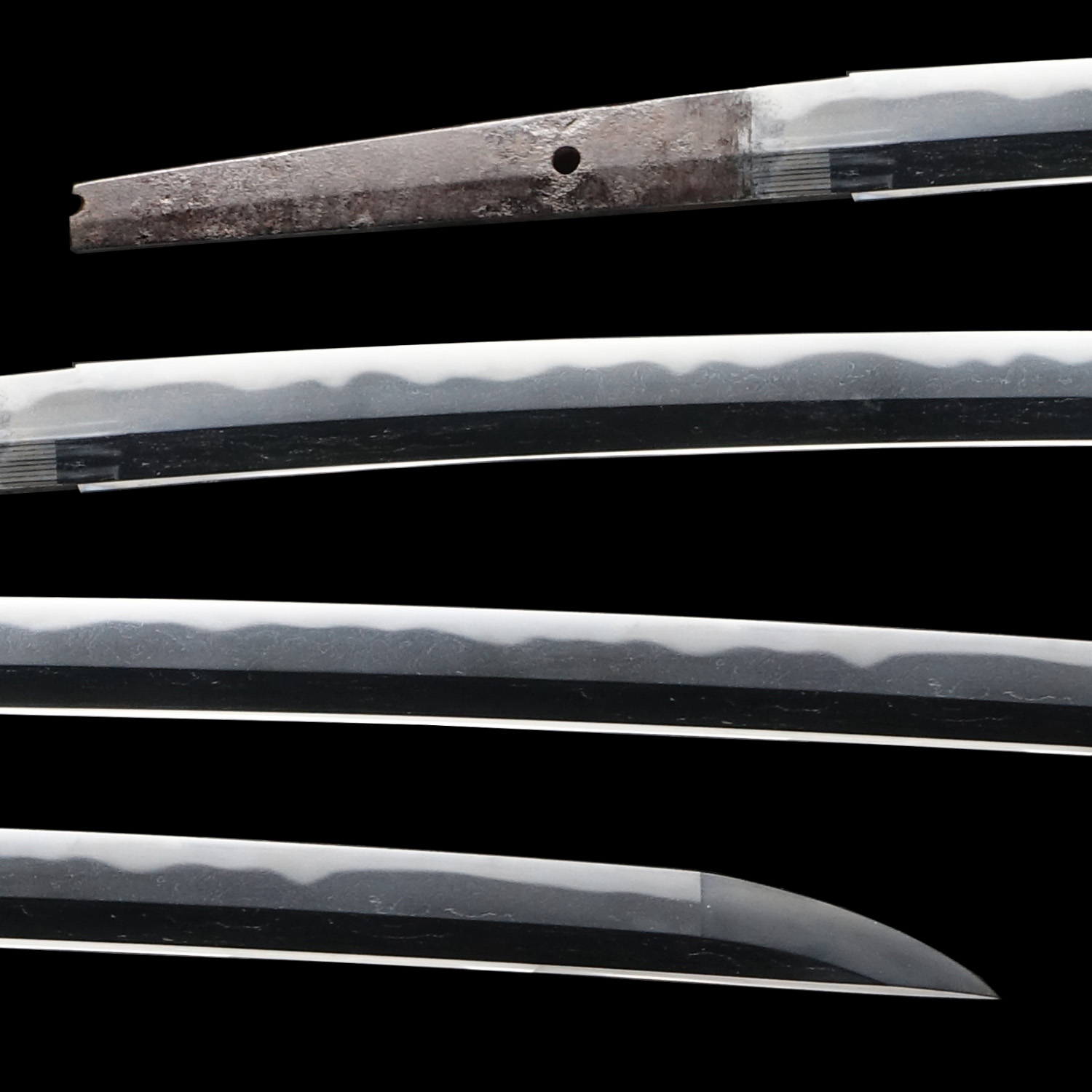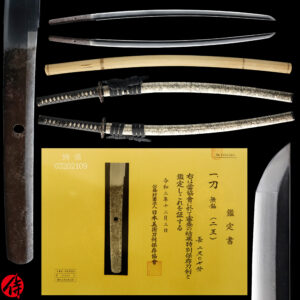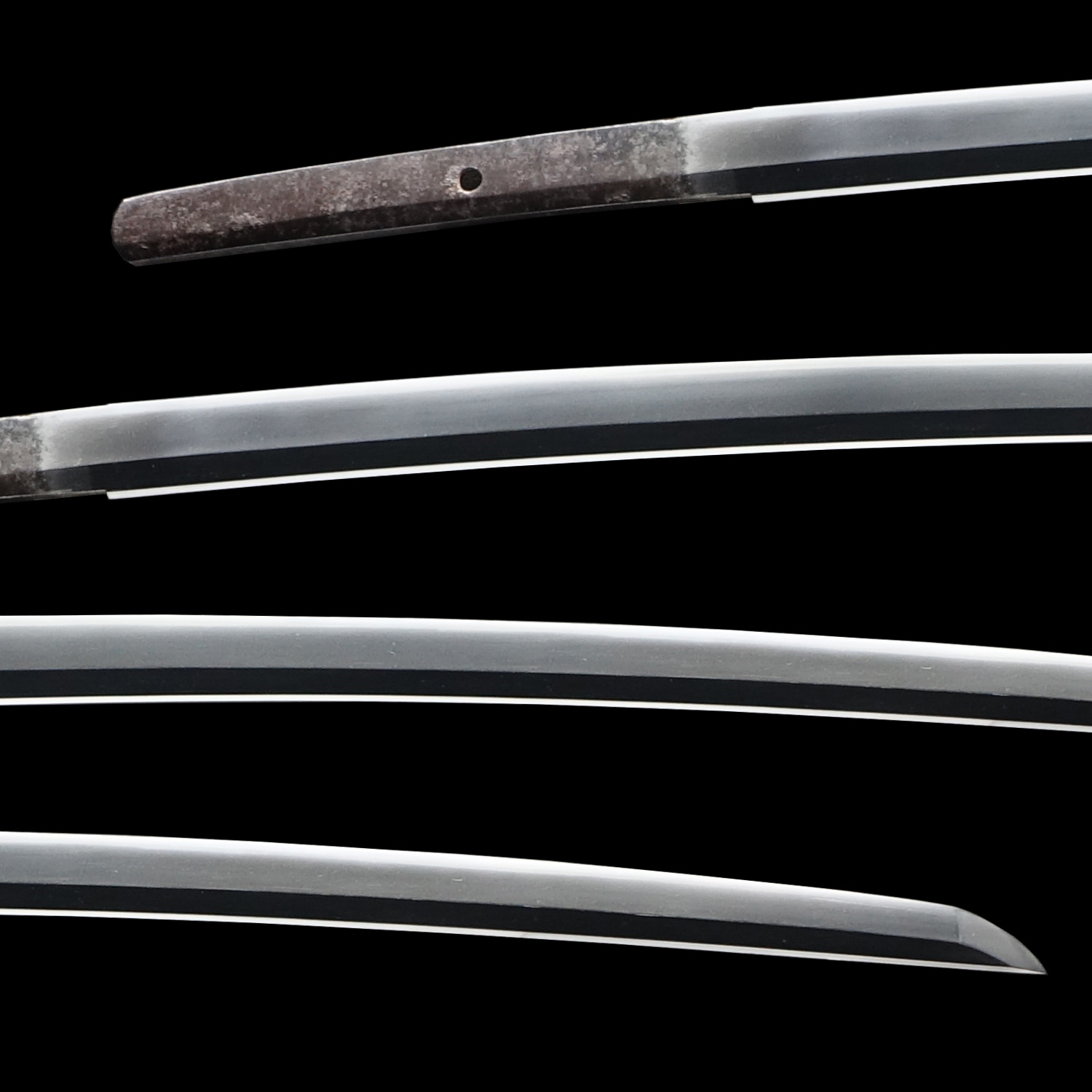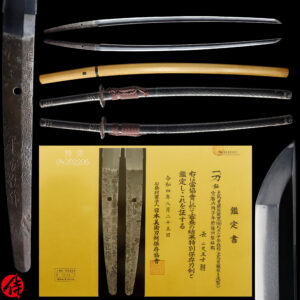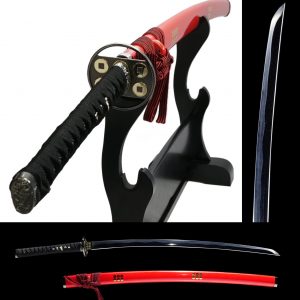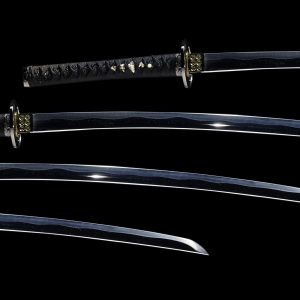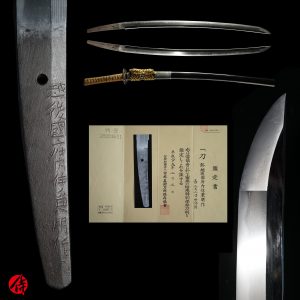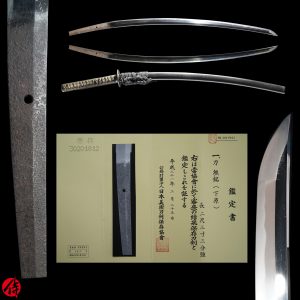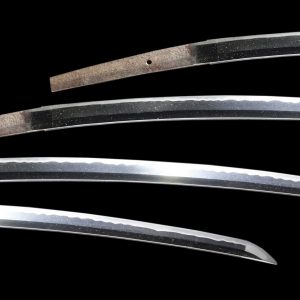Antique Japanese Sword Katana Signed by Yokoyama Sukekane with Tokubetsu Hozon Certificate
【Description】
Summary
This blade was signed by Bizen Osafune Jyu Yokoyama Sukekane(備前長船住横山祐包) Sukekane was active during 1835-1872. Bizen is a place located in today’s Okayama prefecture. And, Osafune is the school he belonged to. Bizen Osafune Jyu means that he resided in this area when he created this blade. Many Japanese swordsmiths inscribed where he lived before engraving his signature on the tang. Sukekane was one of the most famous swordsmiths in Bizen province during the end of the Edo period. He is also known as the 13th-gen Sukesada.
He signed the 58th grandson of Tomonari on the tang as well. Tomomori was a renowned swordsmith in the mid-late Heian period in Bizen province (today’s Okayama prefecture). We presume he signed it to be proud of his ancestry. Sukekane was adopted by Yokoyama Shikanosuke Sukemori, who belonged to Shichiheibei Sukesada school.
One of the most interesting aspects of this blade is that it has Kiritsuke Mei on the tang. Kiritsuke Mei is an engraving that adds provenance to the blade. In this case, it says that in March the 11th year of the Showa era (1936), grandfather 小長谷 sent this sword as a gift to his grandson, 小長谷陸治. We believe this person decided to add Kiritsuke Mei because he found the craftsmanship of this Katana superb, and he wanted it to protect his grandson.
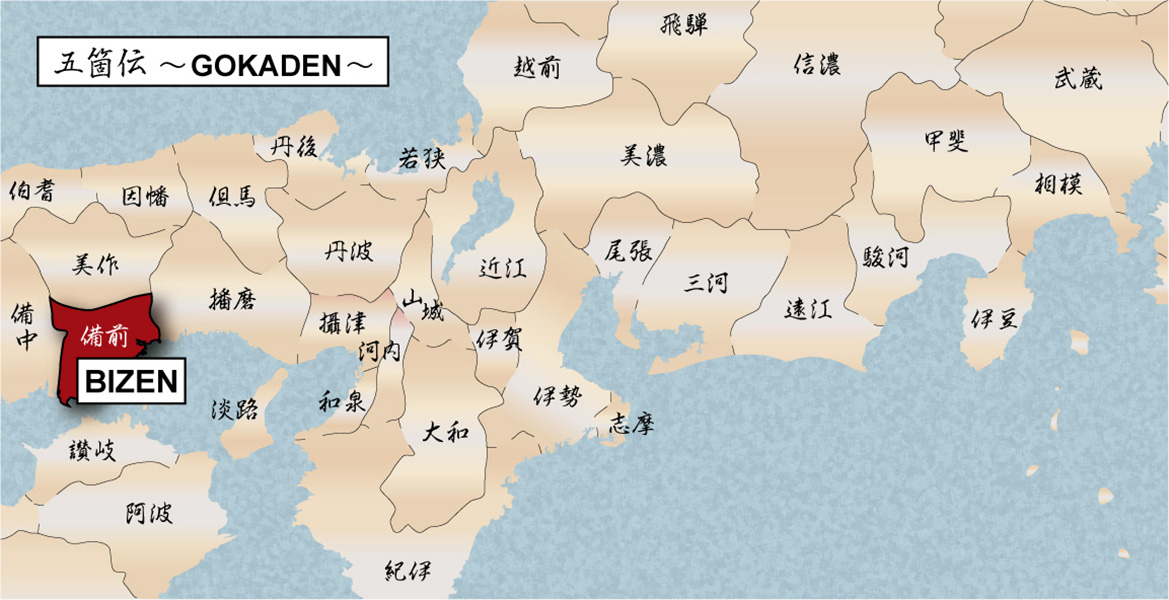
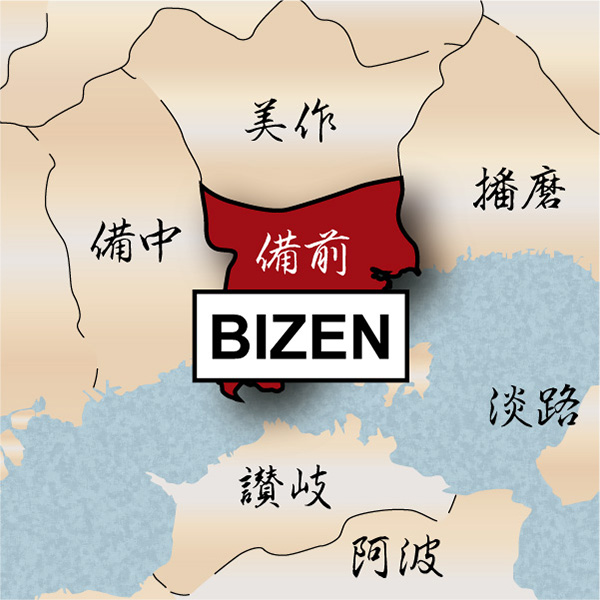
About Sukesada school
Sukekane’s ancestors dated back to Sukesada school, one of the most famous schools, and flourished for generations among Osafune schools(The head branch). There were various styles forged by the generations of Sukesada during the Muromachi-Edo period. There were about 60 swordsmiths who used Sukesada as his maker’s name in Samurai history.
The swordsmiths in Bizen produced many swords during the Muromachi period, as it was in the middle of the Sengoku period(Warring State period). The demand for weapons increased among strong feudal lords. However, The sword-forging tradition of Bizen province almost disappeared because of the disastrous flood of the Yoshii River (1591), which was close to Osafune school. Even after everything was destroyed, there were few remaining swordsmiths. One of them was a group of swordsmiths who signed Sukesada. The main member of the school was Yokoyama Fujishiro Sukesada, the fourth head of Sukesada School. And one of his children was Shichibei no Jyo Sukesada (七兵衛尉祐定). They became one of the pioneers that revitalized the sword-forging business in Bizen province. Sukekane’s father was a descendant of this Sukesada.
It is appraised as a Tokubetsu Hozon Token(特別保存刀剣) issued by NBTHK(Nihon Bijutsu Touken Hozon Kyokai:日本美術刀剣保存協会). This authentication paper was only given to authentic Japanese swords, especially well preserved and high quality with artistic value.
【 Blade】
Cutting Edge Length(Nagasa):68.7 cm (27.0 inches)
Curvature(Sori): 1.0 cm (0.39 inches)

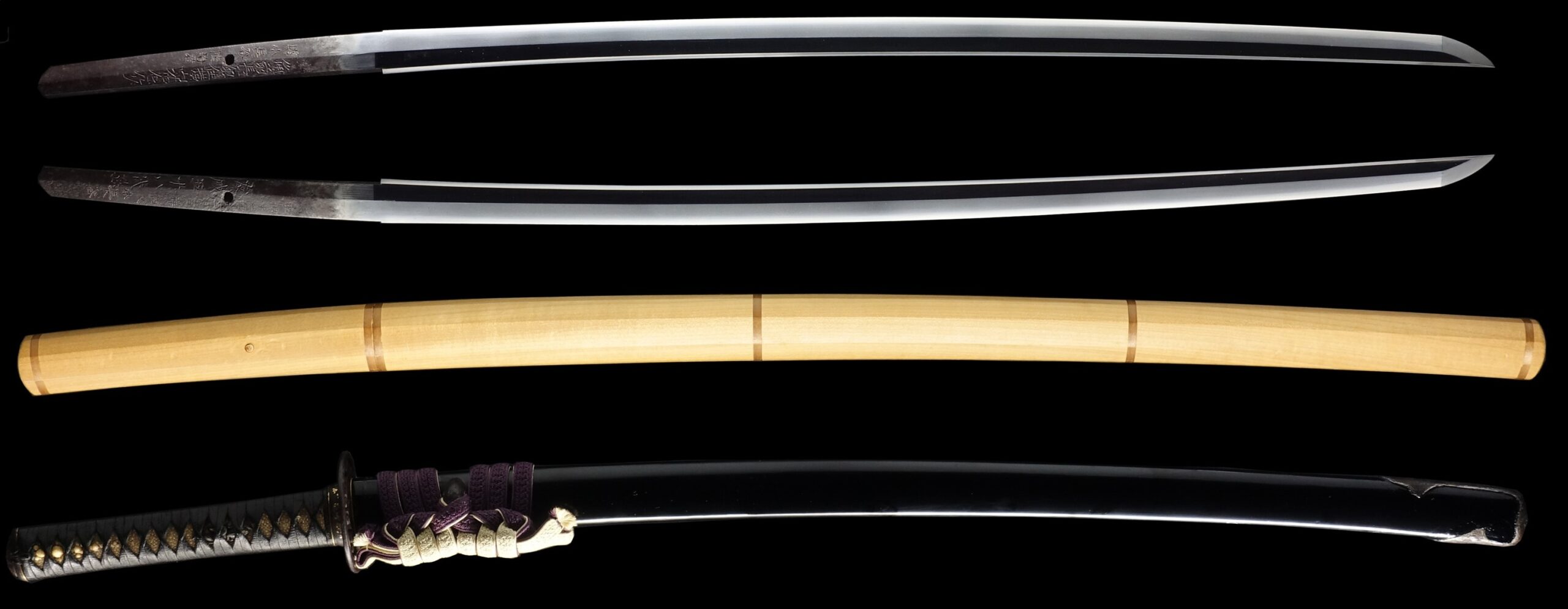
Hamon:
The crystalline structure which forms along the cutting edge of a blade as a result of the hardening process
Jimon(Jihada):
visible steel surface pattern created by folding and hammering during forging process
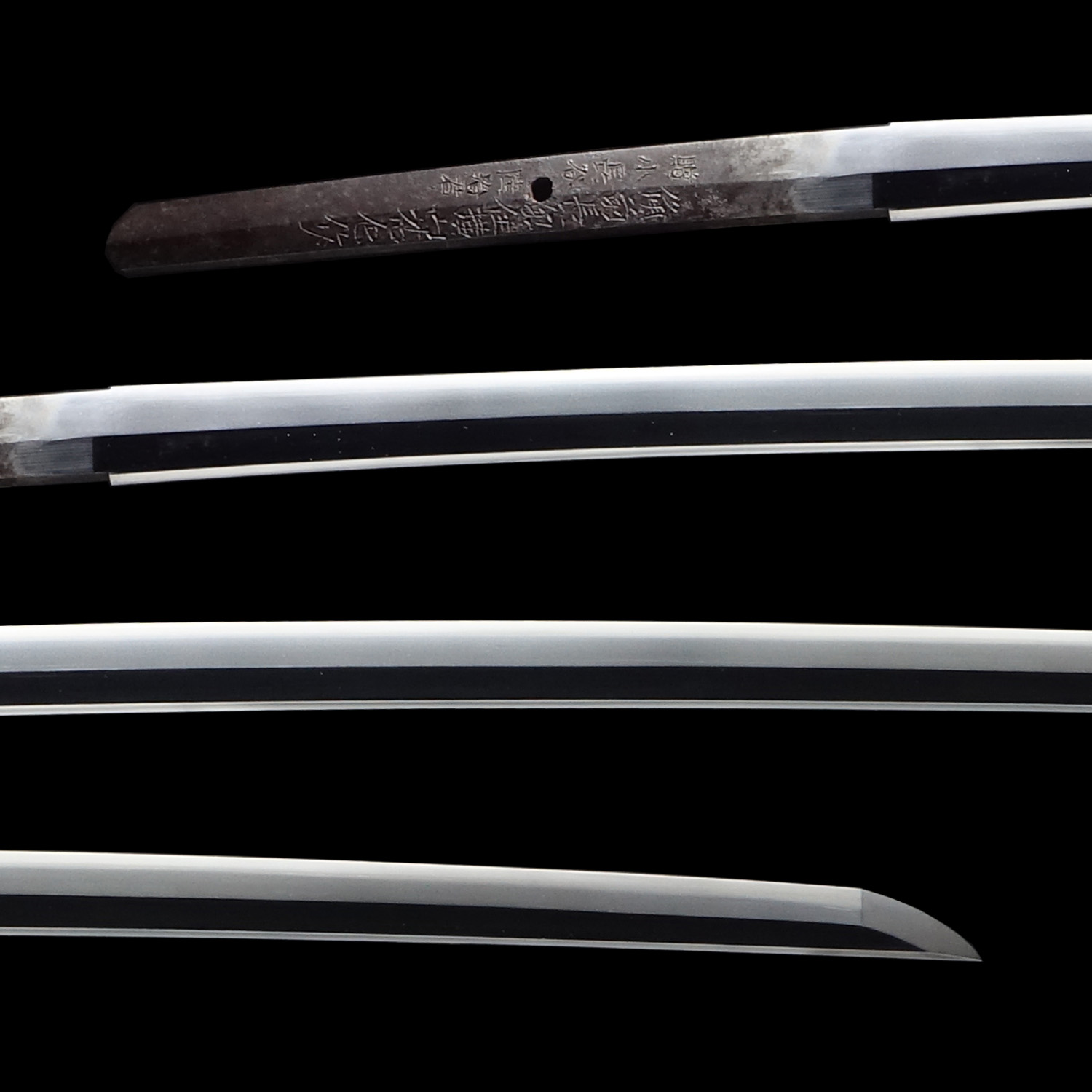


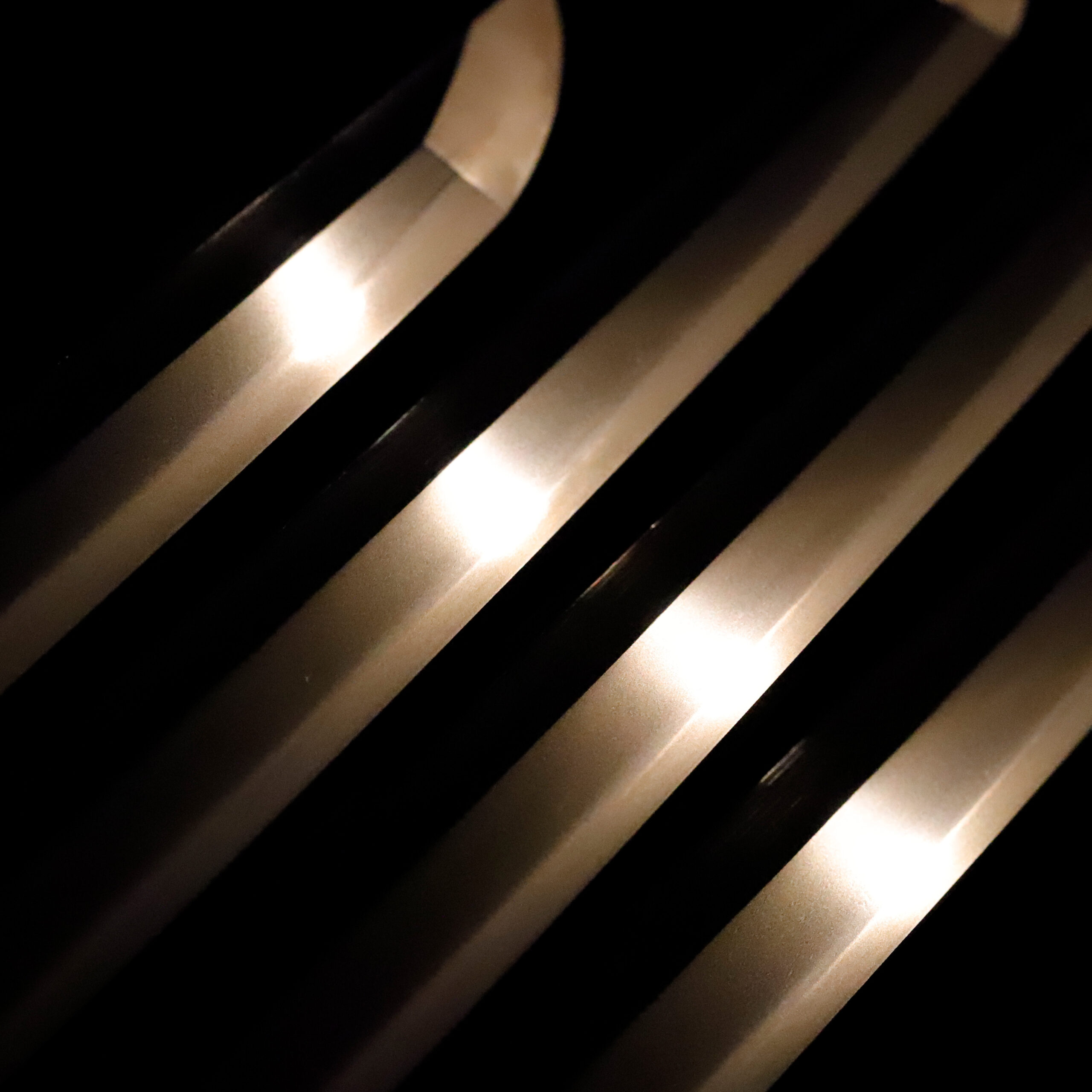

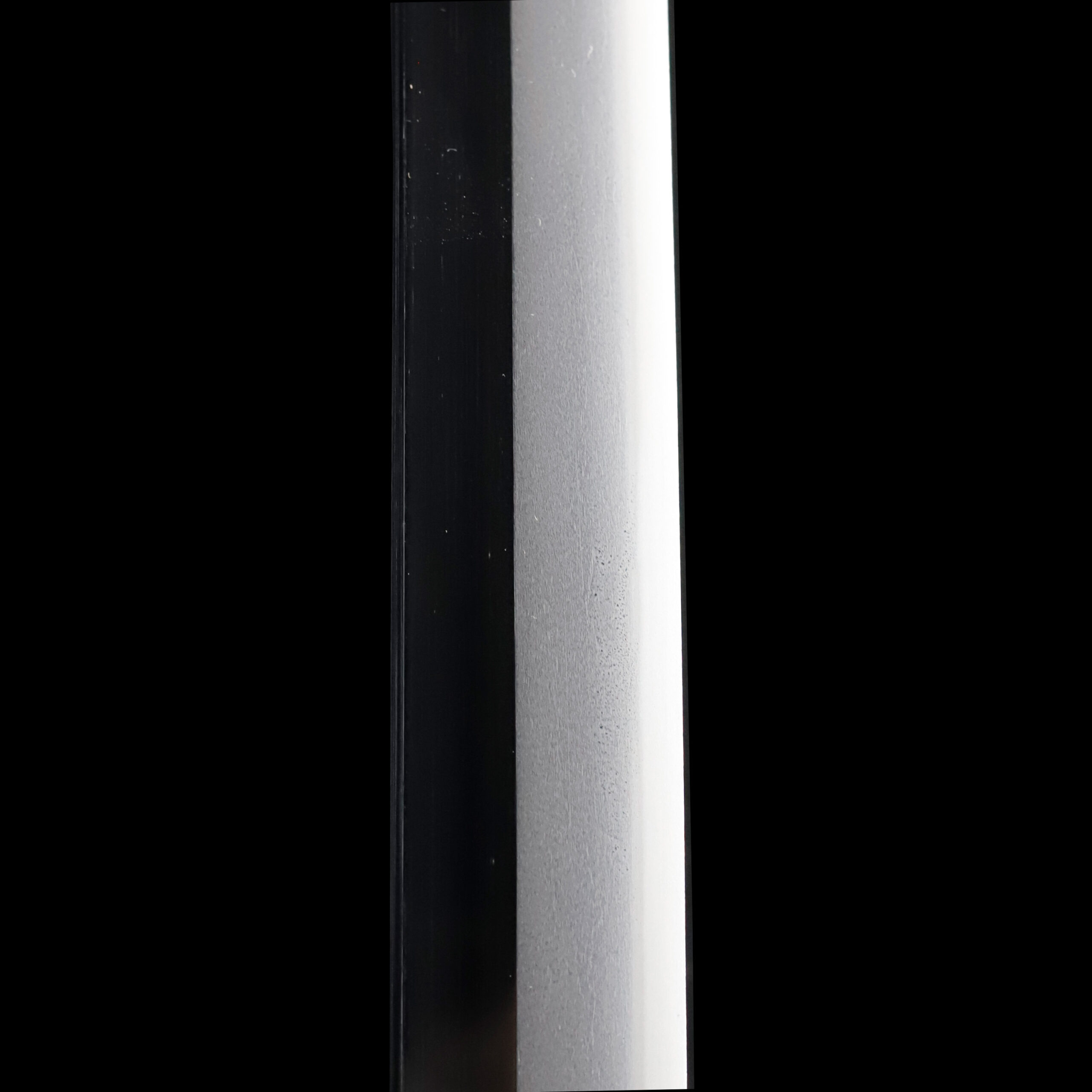
Nakago:Nakago is the tang of the Japanese sword.
Japanese swordsmiths left the black rust on the tang because it prevents red rust while the tang is in its handle. And the discoloration of the tang was created over time, and it is a great indicator for a Japanese sword specialist to estimate when the sword was forged.
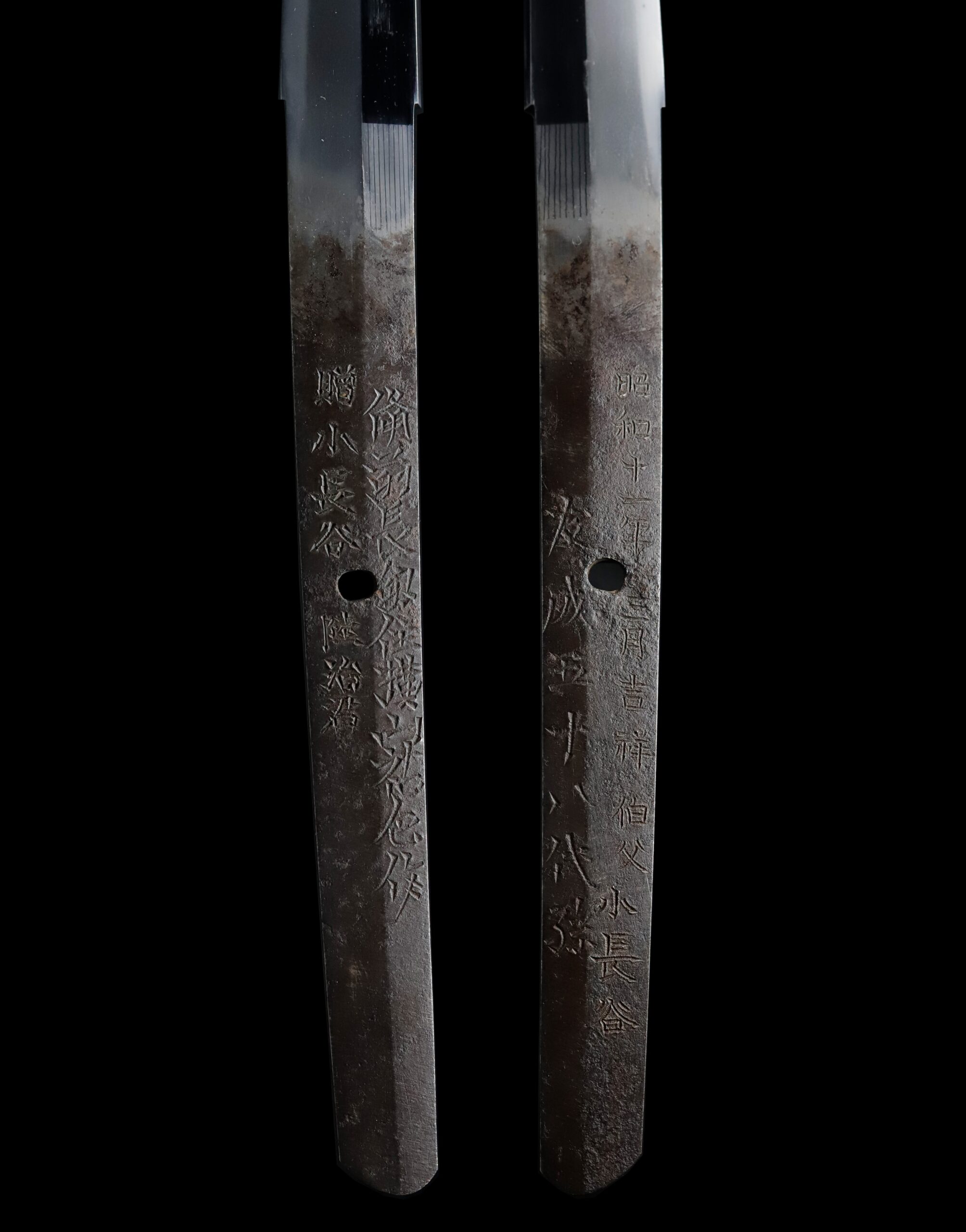
Koshirae: Koshirae is the mounting of the Japanese sword. There are several parts that consist of Koshirae such as Saya(Scabbard), Tsuka(Handle), Tsuba(Handguard).

Fuchi-Kashira:A pair of matching sword fittings that cover the upper and bottom parts of its sword hilt.
Cherry blossoms and the Shippou (七宝) patterns decorate this Fuchi Kashira. Cherry blossom is one of the seasonal things of spring, and it has been cherished for a long time in Japan. Its pattern is designed not only for sword mountings but also for Kimono (着物, traditional Japanese costume) or furnishings. A theory says that the god of grain exists in cherry blossoms. Therefore, this flower pattern has been treated as the symbol of a plentiful harvest.
The Shippou pattern came from the Wachigai Mon (輪違い文). Since a ring spreads in all four directions, the name changed to the Shihou (四方, four directions) and switched to the Shippou. In Buddhism, the seven jewels that adorn the pagoda refer to the blessings of the gods and Buddha. Therefore, the Shippou pattern has been regarded as an auspicious design.
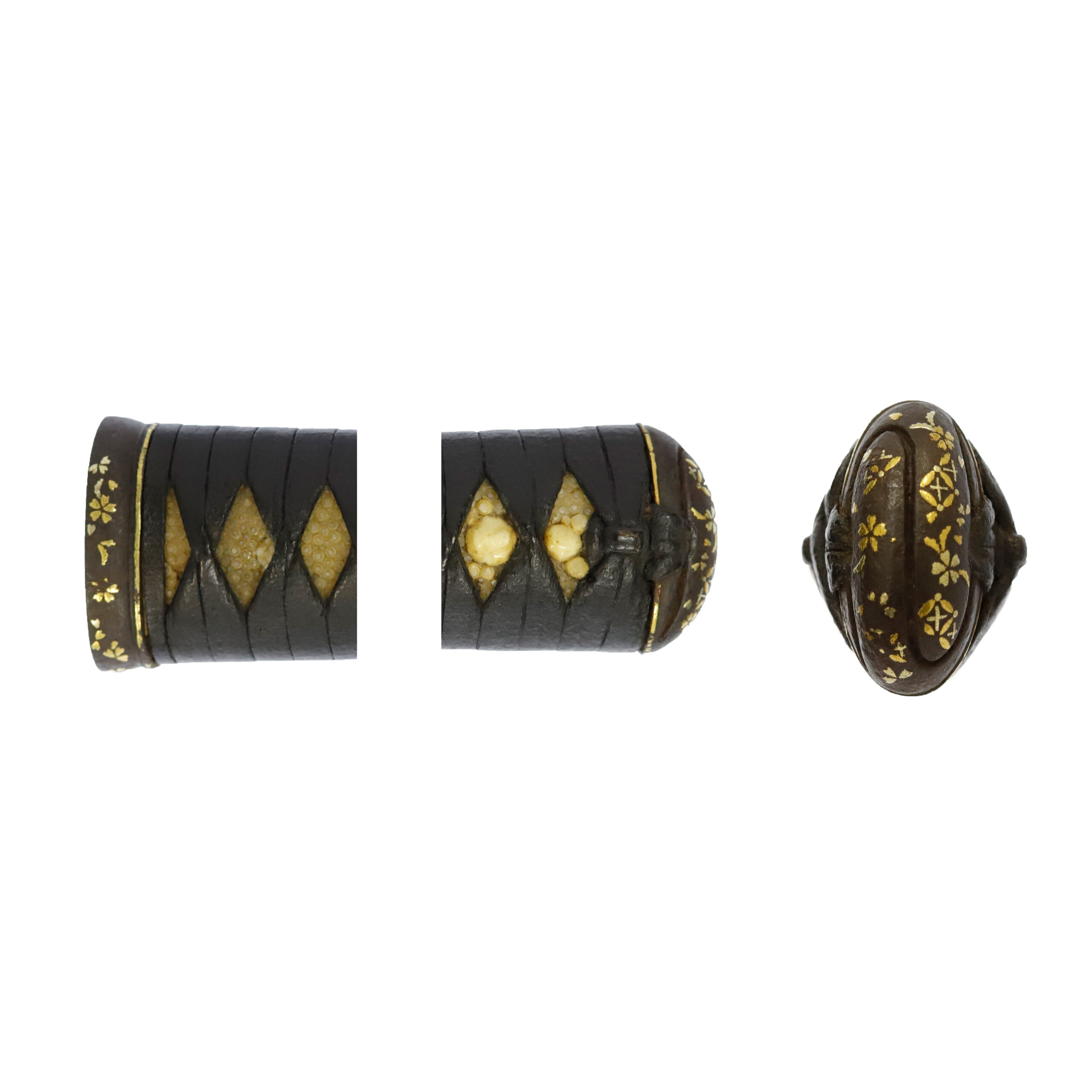
Tsuka and Menuki:Tsuka is the handle of the Japanese sword and Menuki is its decoration.
It is challenging to judge what the motif is. While most of the colorings have already faded due to aging, there are traces of golden paintings. We imagine this Menuki initially had a bright color. We hope you would enjoy such a condition as an antique texture.
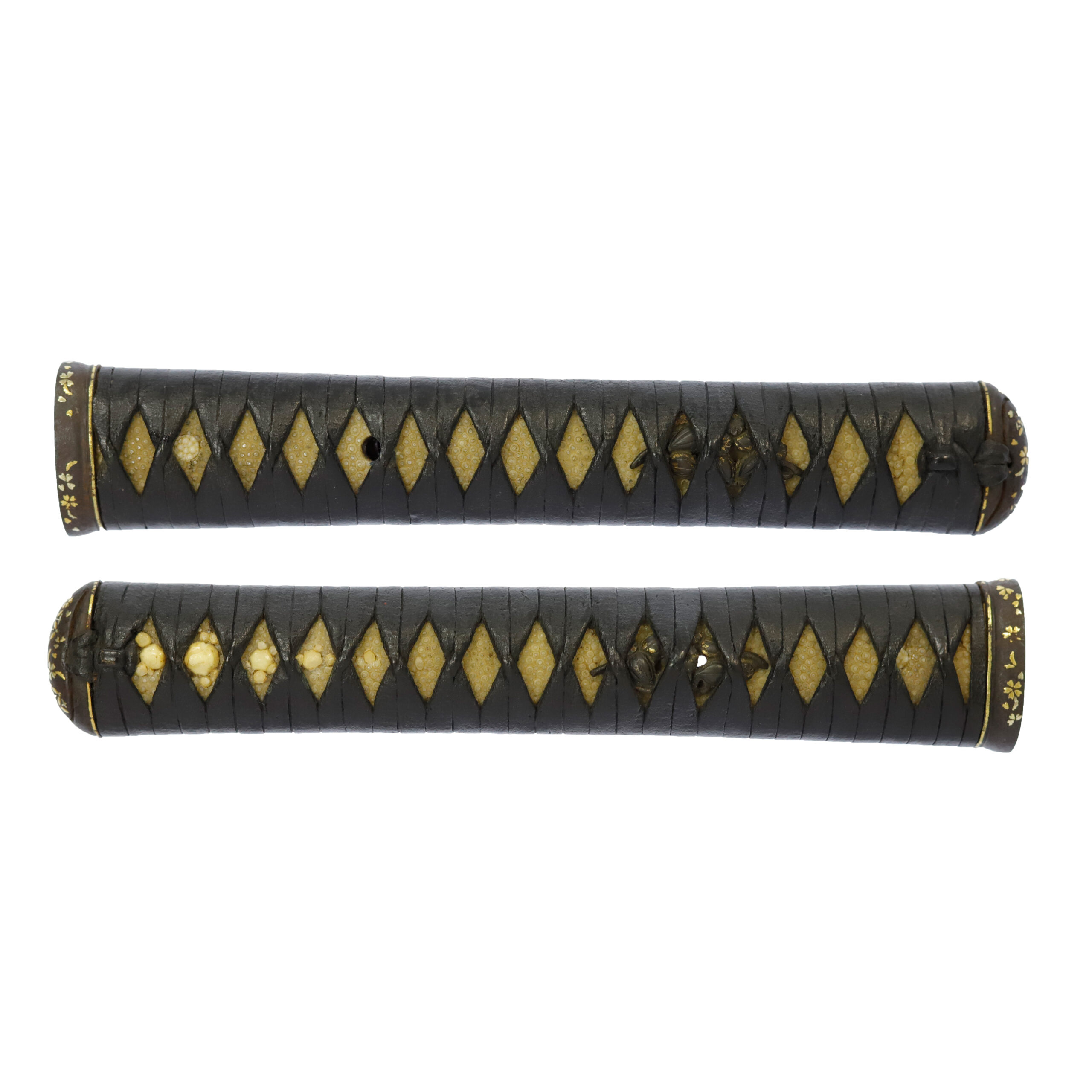
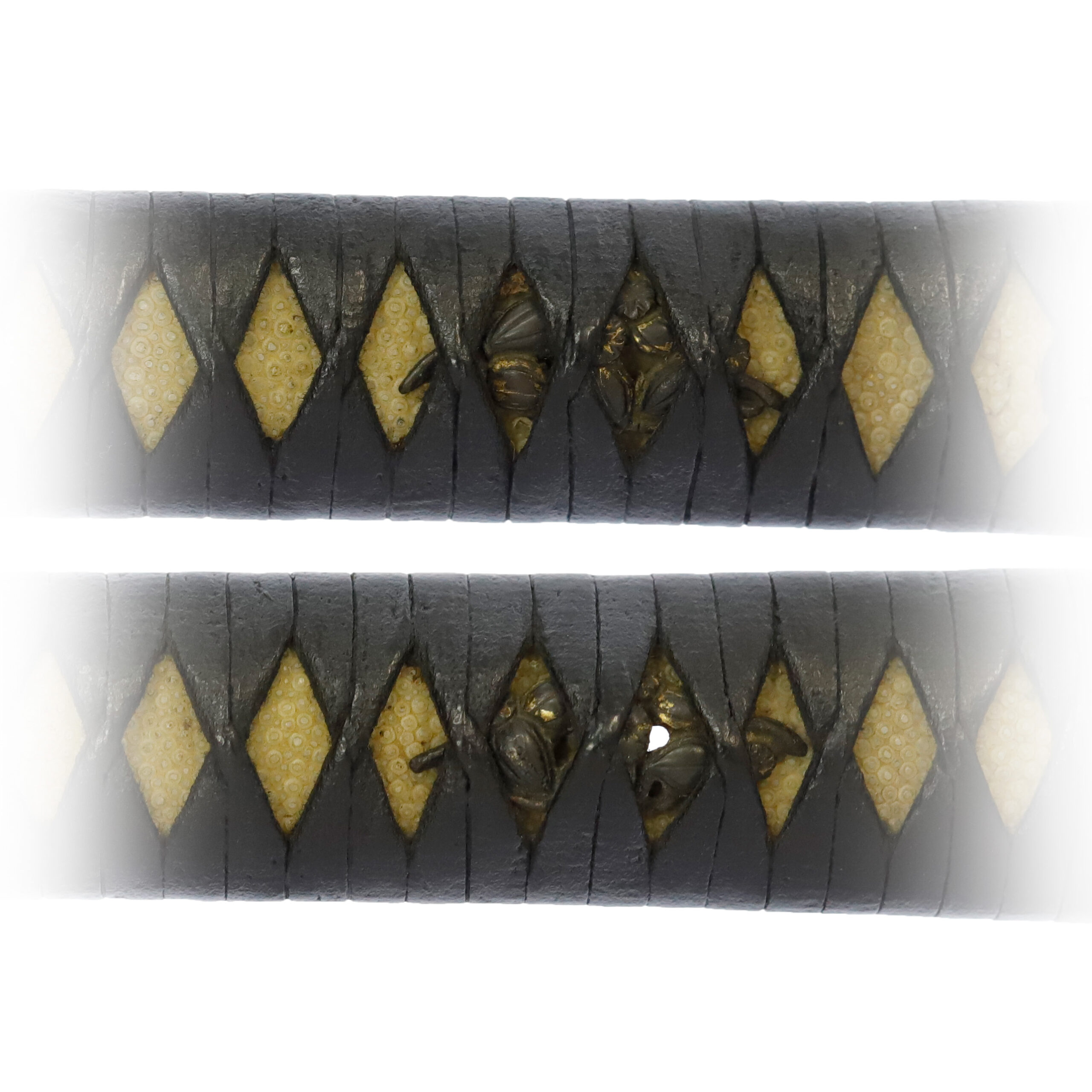
Tsuba and Habaki:Tsuba is the handguard for the Japanese Sword and Habaki is the equipment to make the blade not touch its scabbard inside. It prevents the blade from getting rusty and chipped.
The theme of this Tsuba’s design is a combination of pine trees and wild geese. Wild geese are migratory birds that symbolize autumn and are often depicted in a simplified form, as seen in this Tsuba.
Since pine trees keep their green color throughout the years by withstanding severe heat and cold, people thought this plant pattern represents eternal youth. Furthermore, its color is called the Tokiwa-Iro (常盤色, evergreen trees’ dark green color with brown), and pine trees have another name “Tokiwa-Gi (常盤木).” Tokiwa means immutability, so Tokiwa-Iro is a color that praises green with a wish for longevity and prosperity. This color was appreciated as a good-luck color, especially in the Edo period. The pine tree design gives us an elegant and noble impression; it might be another reason that people love this motif.
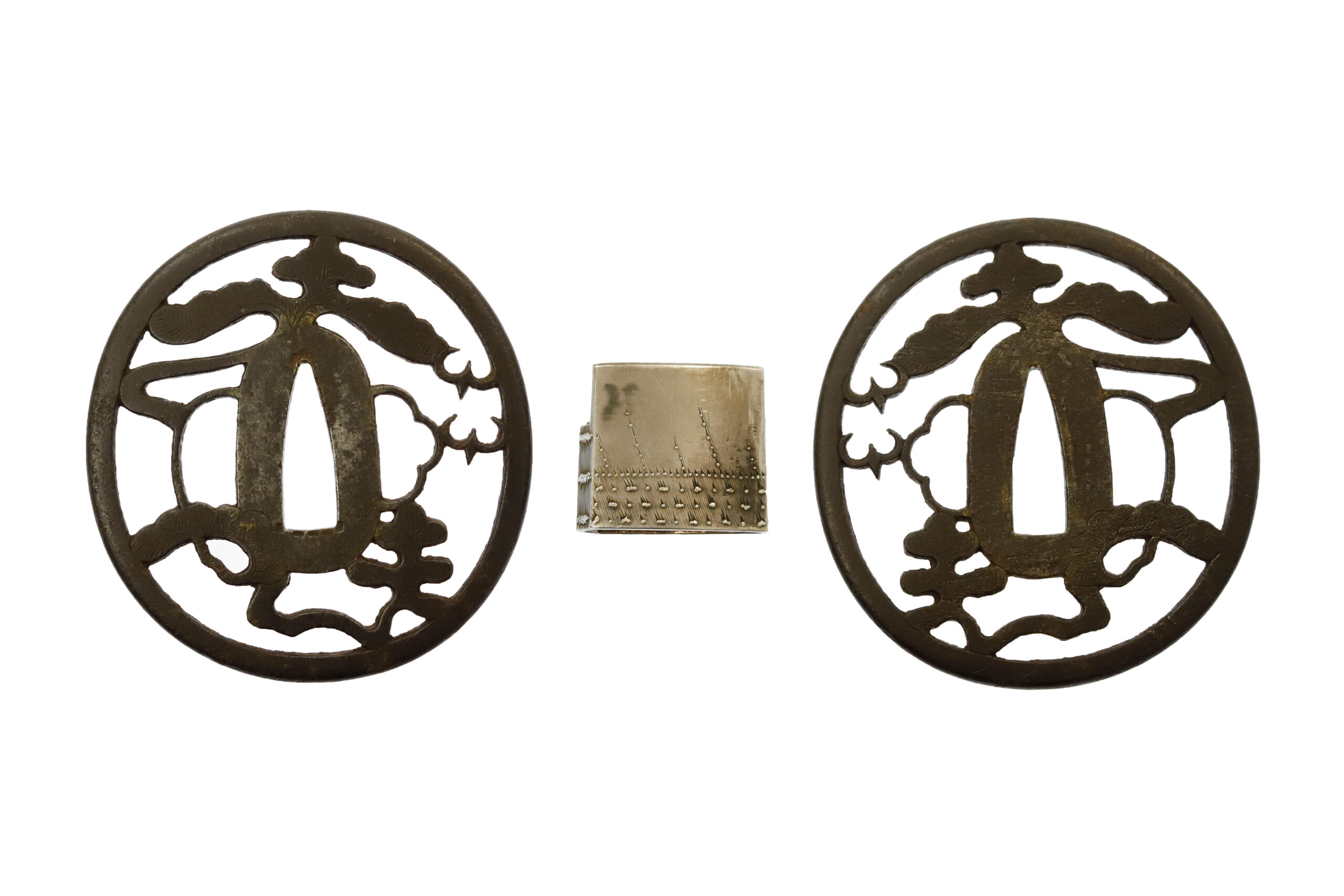
Saya: Saya is the scabbard for the Japanese sword.
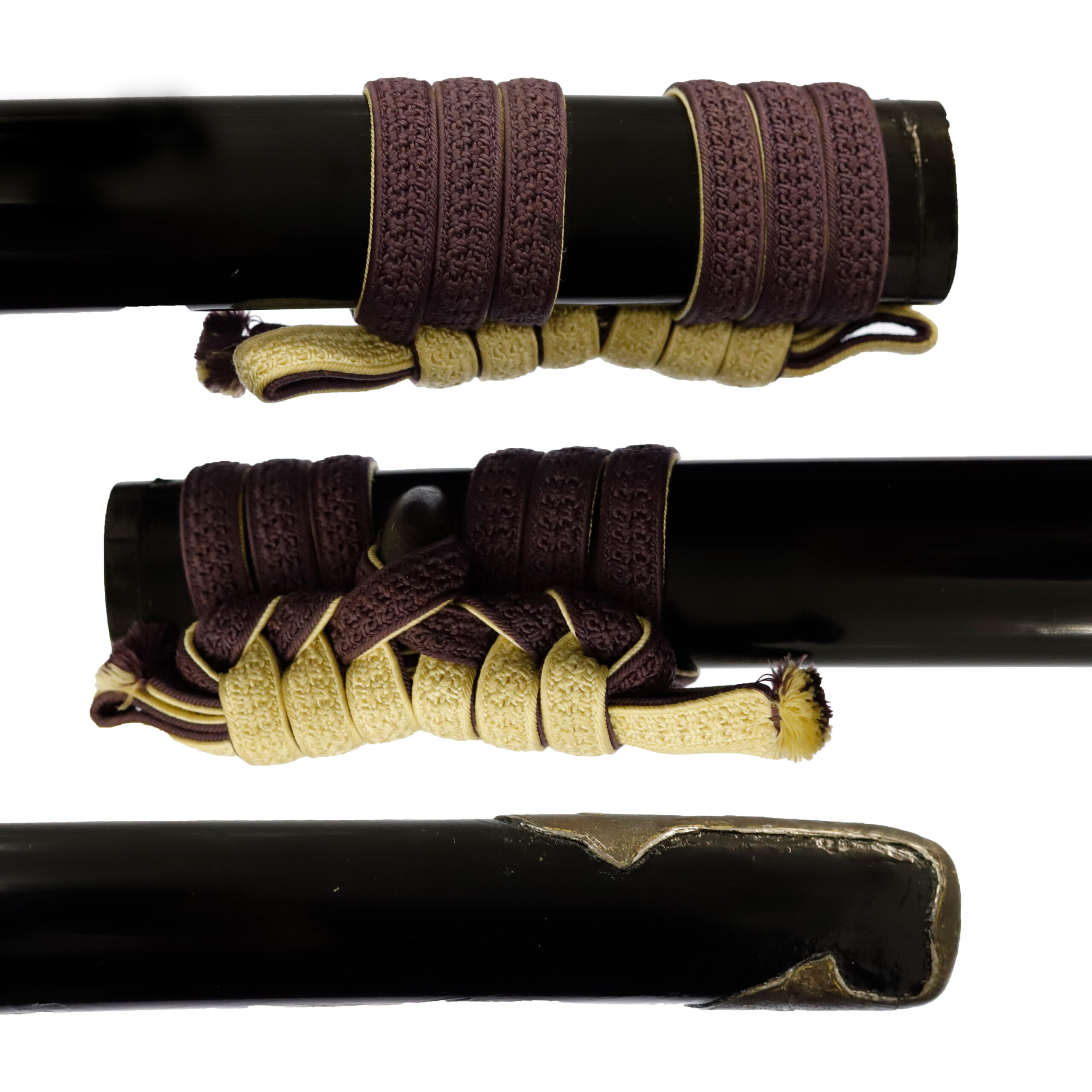
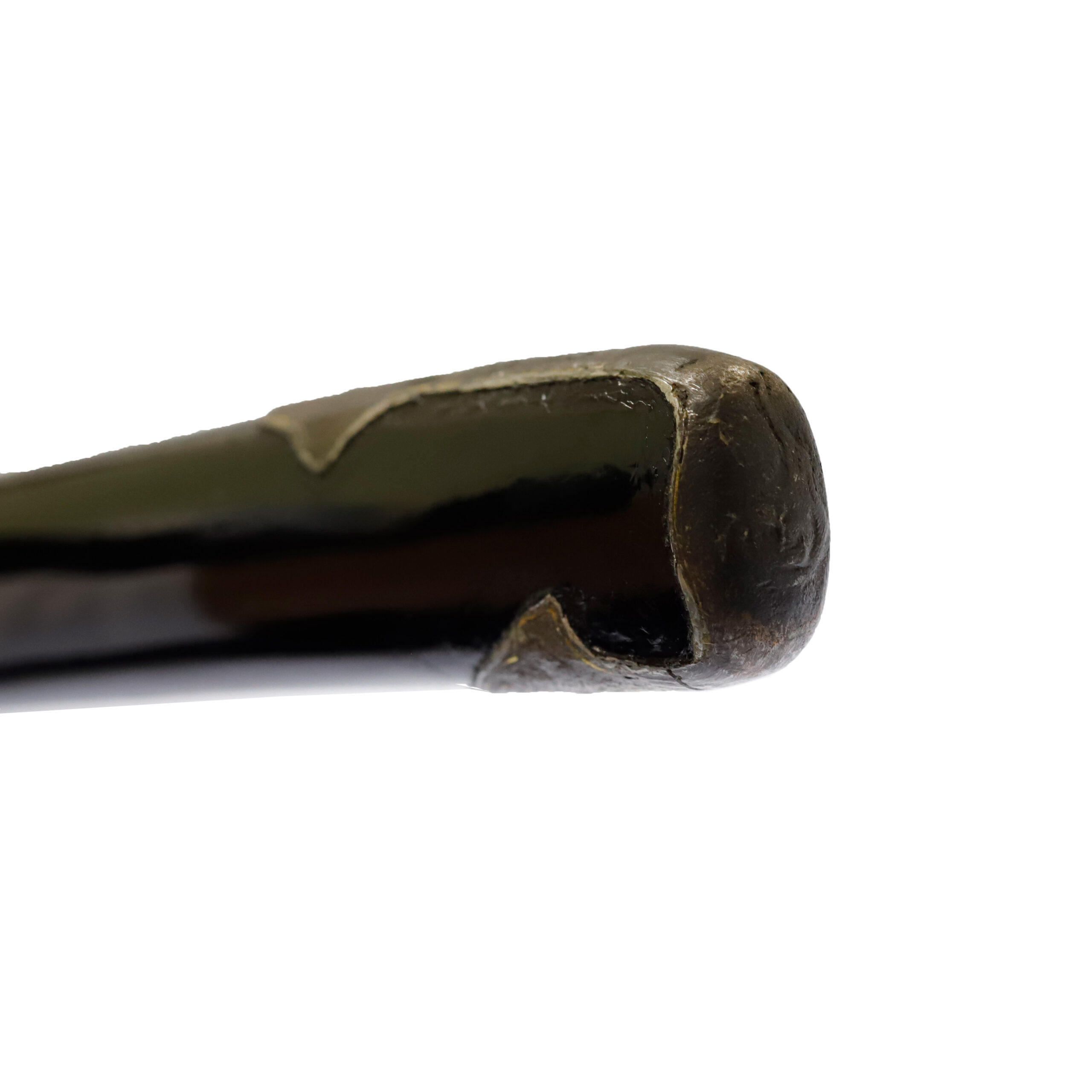
Authentication Paper:NBTHK TOKUBETSU Hozon Certificate for the blade (No. 1016926)
NBTHK, also known as Nihon Bijutsu Touken Hozon Kyokai (the Society for the Preservation of the Japan Art Sword), is one of the oldest Japanese sword appraising organizations in modern-day Japan. They authenticated the blade on December 3rd in the 3rd year of Reiwa (2021). They appraised it as Tokubetsu Hozon Touken, the blade especially worth preserving for Japanese society. The purchaser will receive this original certificate as well. We can also translate what is written into English and make a PDF file for your record if you request.

Registration Number : Osaka 107542
The Board of Education in Osaka prefecture issued a registration paper for this sword . It is called Jyu Token Rui Torokusho(銃刀剣類登録証). Bunkacho(The Agency for Cultural Affairs) acknowledges a Japanese sword with this paper as a work of art.
The sword needs to be traditionally hand-forged and made of Tamahagane carbon steel to be registered in the system. With this paper, its owner in Japan can legally own an authentic Japanese sword. Based on this registration number, we will apply for its export permit.
This paper will need to be returned to the board of education when the sword is being shipped abroad, but you can receive a copy of it. An English translation of this registration paper is available on request.
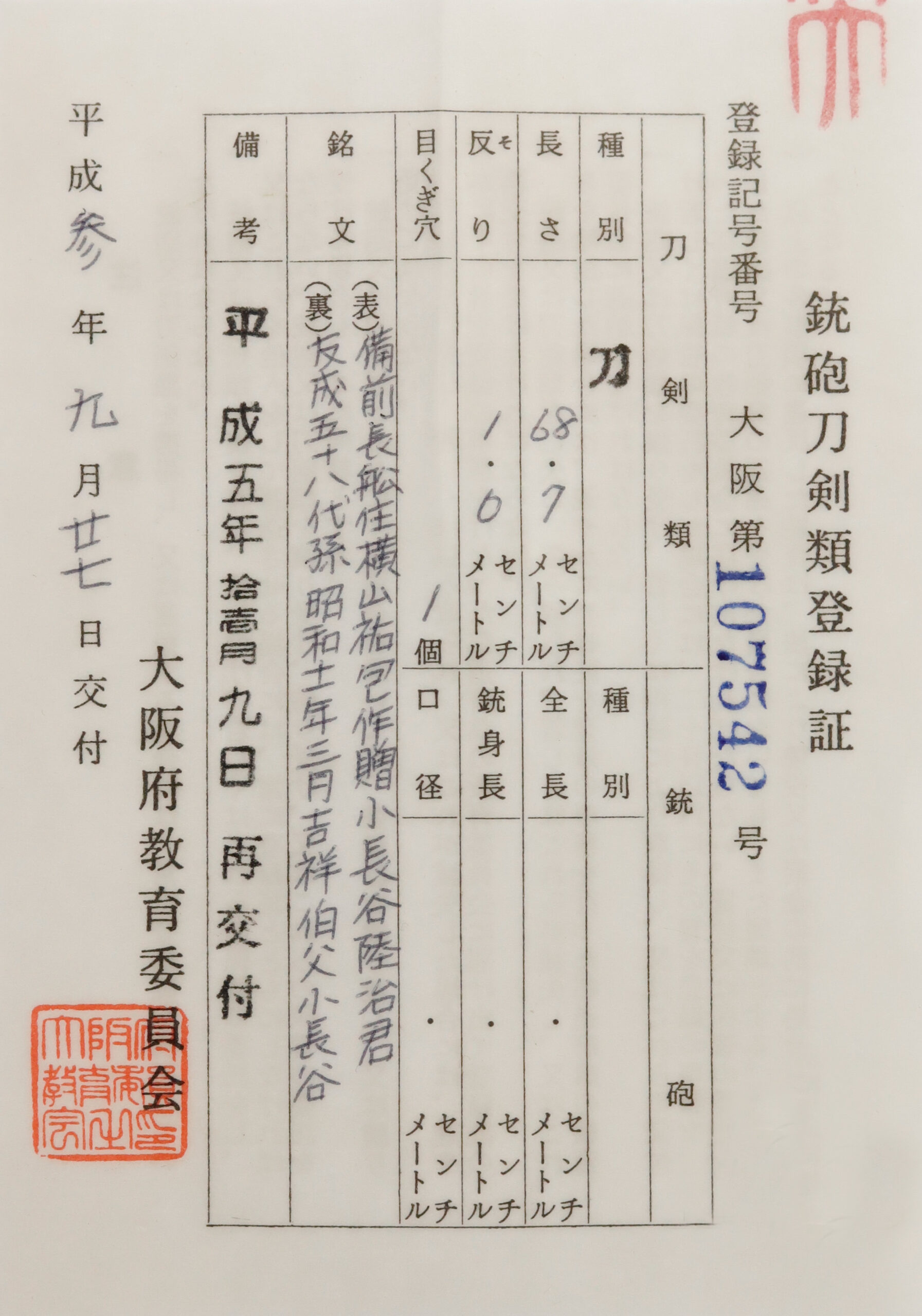

—————————————————————–
【About us】
Samurai Museum is located in Tokyo, Japan, exhibiting antique artifacts related to the Samurai history. Samurai Museum Shop is the place for those who are interested in Japanese culture and craftsmanship. We deal with antique Samurai swords/armor, traditional crafts made in Japan and so on.
【Japanese Sword& Export Process】
The Japanese swords we deal with are hand-forged edged swords made in Japan. It was made from the traditional carbon steel called TAMAHAGANE(玉鋼). Samurai Museum is familiar with the proper legal procedure for an antique/ authentic Japanese sword to be exported from Japan. We have sent more than 500 Japanese swords for the past three years (~2023) to amazing owners who appreciate its historical value.
Each Japanese sword is registered under the Agency for Cultural Affairs and the Board of Education in Japan. They issue a registration paper for each Japanese sword for its owner in Japan to legally possess it. The Japanese sword with its registration paper means it was traditionally hand-forged in Japan.
To legally export the sword from Japan to other countries, we will have to apply for its permit to the Agency for Cultural Affairs(Bunkacho) and return the original registration paper to the Board of Education. It normally takes around 2-4 weeks to receive this permit after submitting required documents. And we would like you to expect at least 1-1.5 months for your order to arrive at your given address after you ordered. For more detailed info, please click here.
It is allowed for residents in Japan to own authentic Japanese swords without a special license as long as they come with registration papers. Please feel free to contact us if you are a resident of Japan, whether temporarily or permanently. We will also assist you when you leave Japan and need to obtain an export permit. If you live in Japan, please click here before you make a purchase.
【Payment Method】
We accept payment through Stripe (Credit card), PayPal, Apple Pay or ChromePay, all of which are secure payment methods. Also, you don’t need to make an account on Stripe for the checkout. If you prefer other payment method, please contact us. After confirming your payment, we will apply for an export permit. You may either pay in JPY, USD, AUD, CAD,EUR CHF or GBP. The price is set in Japanese Yen. Prices in other currencies are automatically calculated based on the latest exchange rate.

* If the amount is above 1 million JPY, Stripe or wire transfer will be the only options for payment.
【Shipping】
We have shipped authentic Japanese swords to the USA, UK, Canada, Mexico, Germany, France, Hong Kong and Australia. If you don’t live in these countries and like to order, please contact us first before making a purchase. We offer Free International Shipping as long as we can send antique Japanese swords by EMS.
We normally ship by EMS(Express Mail Service) provided by Japan Post. We will send you a tracking number for your order as soon as we hand it to the post office. We will put 100 % insurance on the shipping document without any extra charge. Based on the total amount, there might be a duty tax or other fee for you to pay, depending on the countries. We use package cushioning to protect the item and put it in a PVC pipe, which is one of the most secure packages because of its durability.
It will normally takes 5-14 days for the item to arrive at your given address after we dispatch it. Time of delivery is estimated as accurately as possible by the carrier but does not take into account any delays beyond our control such as by inclement weather, post office holiday seasons.
* If you live in Australia and like to purchase an authentic Japanese sword, please click here to know the detail.
*Please keep in mind that due to the spread of COVID-19, there might be delays in shipping. If you like to know the detail about shipping, please feel free to ask us.

【Review】
Here is one of the reviews we received from a customer who purchased an authentic Japanese sword from us. For more reviews, please click here.
“My experience overall with the whole process was wonderful. I had many questions about the history and process to purchase these treasures. All my questions were answered very timely and complete. The staff is very knowledgeable and very well versed if any questions do arise.”
【How to make sure the condition】
Please keep in mind that what you are going to purchase is an antique item. We uploaded high resolution photos for you to check its condition thoroughly. If you like to see more photos with different angles, please feel free to contact us. We will be happy to send them to you so that you can make informed decision. It is essential for us to know that you are happy with your choice of a sword. and we are prepared to use the best of our ability to serve you.
【How To Contact Us】
Please contact us through email, Facebook Messenger or Live Chat if you have any questions. You can find each icon on the right side of the website. Please click one of them to reach us. We will reply to you within 1-2 business days.
【The Art of Nihonto (Japanese Sword)】
Samurai’s history is a profound, eloquent legacy of ancient Japanese warriors in which millions of people worldwide are being fascinated. If you like to find out the art of Nihonto, please click here.
【A Guide to Japanese Sword Maintenance】
After acquiring an genuine Japanese sword, it is also important to know how to take good care of it. Here is the special video for you. Mr. Paul Martin, Japanese sword expert, shows you how to give proper maintenance to your sword. By mastering how to clean the Japanese sword, its aesthetic beauty will last forever.
When you purchase a Japanese sword from us, you can get a Free Japanese sword maintenance kit. It comes with four tools(Choji Oil, Uchiko Whetstone Powder, Peg remover, Oil Applicator). By watching the video instruction above , you can enjoy learning how to maintain your Japanese sword while appreciating it. If you have any difficulty assembling the sword or cleaning the blade, you can feel free to contact us.


MORE ANTIQUE JAPANESE SWORD FOR SALE
SWORDS WITHOUT CERTIFICATES FOR SALE
LEARN JAPANESE SWORD TERMINOLOGY
Thank you for reading all the information on the page. If you have any difficulty choosing the right Japanese sword for you, we will be more than happy to help you find the one that speaks to you the most. Please feel free to contact us.
